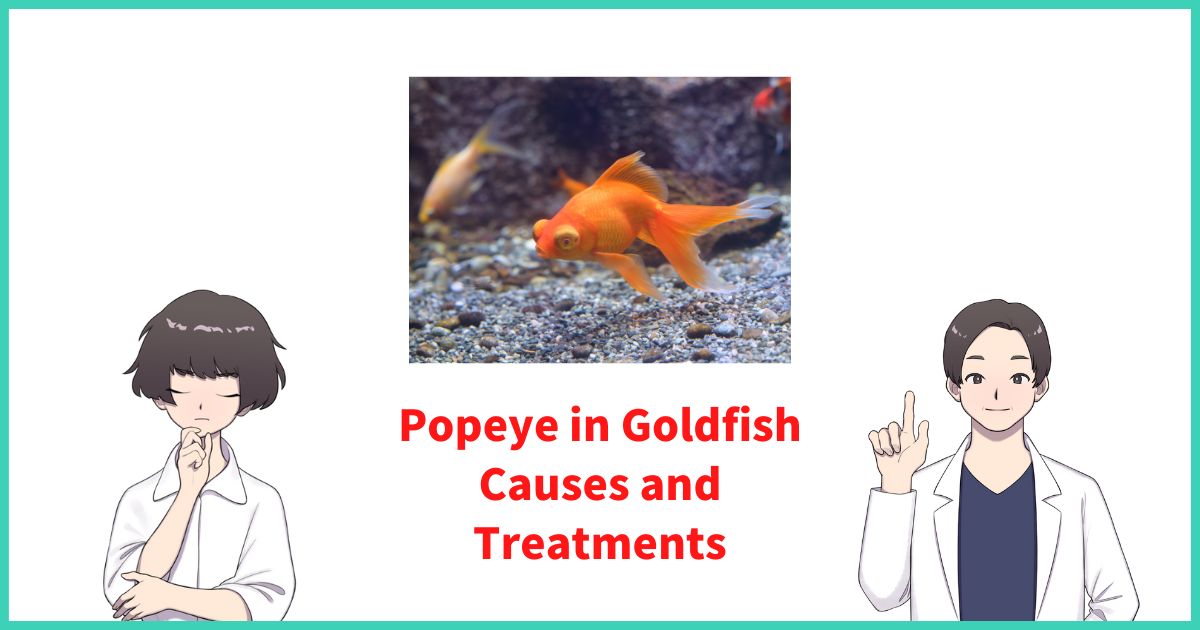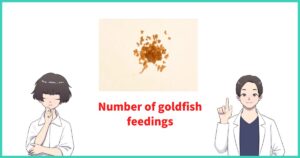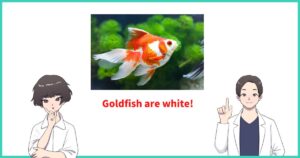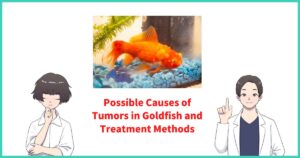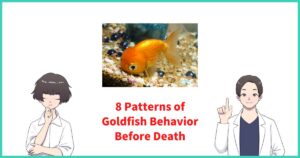Have you ever been shocked to see your goldfish’s eyes suddenly swell up or bulge out? It might be a disease called “Popeye.” If left untreated, Popeye can cause goldfish to lose their eyesight, or even their eyes. In the worst cases, it can be a life-threatening disease.
Although there is no 100% guaranteed cure for advanced stages of Popeye, early detection and proper treatment can improve the condition. In this article, we will explain in detail the symptoms, causes, treatment methods, appropriate treatment environment, and prevention measures for Popeye in goldfish.
What is Popeye in Goldfish? Explaining Initial and Severe Symptoms
Popeye is a disease in goldfish where the eyes abnormally swell up, and the eyeballs protrude. Early detection and proper treatment are crucial for this disease. If left untreated, there is a possibility of eye rupture or blindness, so caution is necessary. Popeye gradually worsens from initial symptoms, so the owner must closely observe the goldfish’s condition and quickly take action if any abnormalities are noticed.
Initial Symptoms of Popeye
The initial symptoms of Popeye start with swelling around the eyes or slight protrusion of the eyes. The eyes may also become cloudy. Furthermore, abnormal swimming posture and other unusual behavior may be observed. It is essential not to overlook these symptoms.
Cloudy Eyes
One of the initial symptoms of Popeye is cloudy eyes. When the eyes become cloudy and white, the goldfish’s vision may deteriorate, and it may become unable to eat. Cloudy eyes are often caused by bacterial infections. Deterioration of water quality and stress can lower the goldfish’s immunity, making it more susceptible to bacterial infections.
Abnormal Swimming Posture
As Popeye progresses, the goldfish’s swimming posture may become abnormal. It may swim tilted to one side, slow down, or stop. This may be due to stress caused by eye abnormalities or deteriorating vision. Abnormal swimming posture can also be seen in other diseases, so it is necessary to make a comprehensive judgment based on other symptoms.
Swelling Around the Eyes

As an initial symptom of Popeye, the area around the eyes may swell up. As the swelling around the eyes increases, the eyeballs will gradually start to protrude. The swelling around the eyes is caused by inflammation due to bacterial infection. As the swelling worsens, the eyes get pushed out, and the eyeballs protrude.
Protruding Eyes
As Popeye progresses, the eyes start to protrude. Initially, the eyes may only slightly bulge out, but gradually the eyeballs will become more prominent. When the eyes protrude, there is a higher risk of the cornea drying out or getting injured. Moreover, as the eyes bulge out, the goldfish’s vision may deteriorate, and it may become unable to eat.
Severe (Late-Stage) Symptoms of Popeye
As Popeye worsens, more serious symptoms appear. The eyes may extremely protrude, bleed, or become blind. If these symptoms are observed, immediate treatment is necessary.
Extreme Protrusion of Eyes (Eyes Almost Falling Out)
As Popeye worsens, the eyes may protrude to an extreme extent. The eyes may bulge out so much that they appear to be on the verge of falling out. In this condition, the risk of corneal damage and infection becomes very high. Moreover, as the eyes protrude, the goldfish may become unable to eat, leading to malnutrition.
Bleeding from the Eyes
In severe cases of Popeye, bleeding from the eyes may occur. The bleeding is caused by the rupture of blood vessels in the eyeball. If blood is coming out of the eyes, there is a high possibility that the infection has progressed. If the bleeding continues, the goldfish’s strength may decline, potentially leading to death.
Loss of Vision (Blindness)
If Popeye is left untreated, in the worst cases, blindness may occur. If the eyeballs protrude for an extended period, the cornea may get damaged or infected, leading to loss of vision. Furthermore, if the eyeballs rupture, blindness is unavoidable. If the goldfish becomes blind, it will be unable to eat and will grow weak.
Causes of Popeye in Goldfish
Several factors can contribute to the onset of Popeye in goldfish, but bacterial infection is the primary cause. In particular, a resident bacteria called Aeromonas is said to be deeply involved.
Moreover, poor water quality, stress, and injuries can also influence the onset and worsening of Popeye. Here, we will explain each cause in detail.
Lowered Immunity Due to Stress
Goldfish are sensitive to environmental changes and are prone to stress. Sudden changes in water temperature, overcrowding, deterioration of water quality, and attacks from other fish can cause stress, which may lower the goldfish’s immunity. When immunity is lowered, resident bacteria in the body can multiply more easily, increasing the likelihood of bacterial infections. Popeye often occurs due to such bacterial infections.
Activation of Aeromonas Bacteria Due to Poor Water Quality
When the water quality in the goldfish tank deteriorates, Aeromonas bacteria become active and multiply more easily. Aeromonas bacteria are normally present on the body surface and in the intestines of goldfish without causing problems.
However, when the water quality worsens, Aeromonas bacteria can abnormally proliferate, invade the goldfish’s body, and cause infections. Popeye is one of the infectious diseases caused by Aeromonas bacteria.
Moreover, motile Aeromonas is also said to cause pinecone disease. Therefore, if you notice symptoms such as body swelling or raised scales in addition to Popeye, prompt medication baths become necessary.
Infection by Resident Aeromonas Bacteria
Aeromonas bacteria are resident bacteria found in the tank and on the body surface of goldfish. In healthy goldfish, Aeromonas bacteria do not cause problems. However, if the goldfish’s immunity decreases for some reason, Aeromonas bacteria can multiply and cause diseases like Popeye. Other infectious diseases caused by Aeromonas bacteria include tail rot, dropsy, and pinecone disease. Early detection and proper treatment are necessary for these infections.
Accumulation of Ammonia and Nitrite as a Contributing Factor
Ammonia and nitrite produced from goldfish waste and leftover food are one of the causes of water quality deterioration. When these harmful substances accumulate in the water, they negatively impact the health of goldfish.
In particular, ammonia damages the gills and mucous membranes of goldfish, creating conditions that make it easier for bacteria to invade. Moreover, nitrite reduces the oxygen-carrying capacity of goldfish’s blood, causing poor health. Tanks with poor water quality where these harmful substances accumulate have a higher risk of developing diseases like Popeye.
Bacterial Invasion and Infection through Body Surface Wounds
If a wound forms on the body surface of a goldfish, bacteria can enter through it and cause disease. Particularly in tank environments with poor water quality, bacteria can easily enter through the wound.
Wounds can form on the body surface of goldfish due to fights between goldfish, injuries from decorations, or careless handling by the keeper. If bacteria that enter through the wound cause an infection around the eyes, it may lead to the onset of Popeye.
Key Points for Aquarium Environment to Enhance Treatment Effectiveness
When a goldfish develops Popeye, it is extremely important to provide a proper aquarium environment along with appropriate treatment. This is because goldfish undergoing treatment are more susceptible to stress and the water quality can easily deteriorate due to the influence of medication.

Here, we will introduce two key points regarding the aquarium environment that require special attention during the treatment of Popeye.
Reduce Water Depth to Lessen the Burden on the Eyeballs
Goldfish with Popeye have protruding eyeballs, which puts a significant strain on the eyes. The water pressure on the eyeballs can cause further protrusion and stress. Therefore, during the treatment of Popeye, it is necessary to create an environment that reduces the burden and stress by keeping the water depth shallow to promote faster healing.
Hence, it is crucial to maintain a shallow water depth during treatment.
Specifically, lower the water level until the eyeballs are above the water surface even when the goldfish is lying on its side. This helps to reduce the water pressure on the eyeballs, thereby lessening the burden. However, since the water volume decreases, careful attention to water quality management is essential.
Additionally, providing aeration to allow the goldfish to easily access oxygen near the water surface is also effective. Creating an environment that minimizes stress can contribute to enhancing the goldfish’s recovery capacity.
Perform Frequent Water Changes to Maintain Water Quality During Medicated Baths
In the treatment of Popeye, medicated baths using drugs with antibacterial properties are commonly employed. However, adding medication has the disadvantage of easily deteriorating the water quality. Particularly, if the medication is absorbed by the filter media used in the filtration system, the beneficial bacteria inside the media may die off, leading to the accumulation of ammonia and nitrite. Therefore, it is important to perform frequent water changes during medicated baths to maintain water quality.
Ideally, replace 10-20% of the water volume with fresh water at least once a day. However, when adding new water, be cautious not to cause sudden changes in water temperature or quality.
Also, consider removing the filter during medicated baths to prevent the medication from being absorbed by the filter media. Instead, it is crucial to ensure sufficient oxygen in the water through aeration.
Once the medicated bath is completed, promptly restart the filter to stabilize the water quality. For the next few days, perform daily water changes to ensure that no medication residue remains in the water.
Treatment Methods for Popeye in Goldfish
Popeye in goldfish is a disease that requires early detection and proper treatment. There are two main treatment methods: medicated baths and medicated food. Let’s discuss each method in detail.
Treating Popeye with Medicated Baths
Medicated baths involve adding therapeutic drugs to the aquarium water and immersing the goldfish, allowing the medication to be absorbed through the body surface and gills. Some effective medicated bath agents for treating Popeye include the following:
Effectiveness of Green F Gold Granules and Kanpara D
Green F Gold granules and Kanpara D are known to be effective medications against Aeromonas bacteria, the causative agent of Popeye. These drugs have antibacterial properties and can suppress the growth of bacteria.
Green F Gold granules are dissolved in the aquarium water for use. The medicated bath should be continued for 5-7 days. For Kanpara D, add 0.1mL per 1L of aquarium water and continue the treatment for 2-3 days. During the medicated bath, it is important to increase aeration and maintain the water temperature at 26-28°C.
However, medicated baths carry the risk of stressing the fish and deteriorating water quality, so caution is necessary. Be sure to carefully read and follow the instructions regarding the dosage and duration of the medication.
Enhancing Treatment Effectiveness by Combining with Salt Baths
Combining medicated baths with salt baths can enhance the treatment effectiveness. Salt baths are performed by dissolving table salt in the aquarium water. A salt concentration of around 0.3-0.5% is appropriate.
Salt baths have the effect of protecting the fish’s mucous membranes and balancing osmotic pressure. Moreover, salt also has a bactericidal effect, which can suppress bacterial growth. By combining medicated baths with salt baths, the treatment effectiveness for Popeye is expected to improve.
However, prolonged salt baths can stress the fish, so it is advisable to conduct them for about a week. Additionally, if the salt concentration is too high, it may worsen the fish’s condition, so caution is required.
Treating Popeye with Medicated Food
Medicated food is a method of treating bacteria from within the body by feeding the fish with food mixed with antibacterial agents. Since Aeromonas bacteria, the cause of Popeye, can multiply inside the body, treatment with medicated food can be effective in some cases.
Medicated food is available commercially, but it can also be prepared at home. Medicated food should be given 1-2 times a day for several days. However, since medicated food can stress the fish, it is best to keep the amount and duration of feeding moderate. Additionally, there is a risk of the medication dissolving into the water and deteriorating the water quality, so frequent water changes are necessary after feeding medicated food.
Medicated food is an effective method when the fish has an appetite, but in severe cases of Popeye, the appetite may decrease. In such cases, it is crucial to focus on treatment with medicated baths.
Prevention Methods for Popeye and Other Diseases in Goldfish
The risk of developing Popeye and other diseases in goldfish can be significantly reduced by practicing prevention methods on a daily basis. Here, we will explain the prevention methods for Popeye from the perspective of managing the aquarium environment and reducing stress.
Maintaining Water Quality through Proper Water Changes and Cleaning
Deterioration of water quality is one of the main causes of Popeye. Regular water changes and cleaning of the aquarium are essential to remove ammonia and nitrite generated from goldfish waste and leftover food.
Ideally, water changes should be performed once a week, replacing about 10-20% of the water volume with fresh water. When doing so, be careful not to cause sudden changes in water temperature or quality. Additionally, cleaning the bottom of the aquarium using a siphon is important to remove accumulated debris.
If using a filter, remember to replace and clean the filter media regularly. If the filter media becomes heavily soiled, beneficial bacteria may decrease, potentially leading to water quality deterioration.
Increasing Dissolved Oxygen Levels through Aeration
Goldfish have a high oxygen demand. Insufficient dissolved oxygen levels can increase stress in goldfish and lower their immunity. Therefore, it is crucial to increase the oxygen levels in the water by performing aeration.
Using air stones or air pumps to introduce fine bubbles into the water promotes oxygen uptake at the water surface. Particularly during high water temperatures in summer and during medicated baths, it is important to increase aeration.
Avoiding Overcrowding and Minimizing Stress
Goldfish are prone to experiencing stress when overcrowded. Stress leads to a decrease in immunity, increasing the risk of developing Popeye. A suitable stocking density for goldfish is approximately 1-2cm of fish body length per liter of water.
Moreover, goldfish have a strong territorial instinct, so stress caused by aggression between individuals can also be problematic. Especially during the male breeding season, aggressive behavior associated with breeding can intensify. Avoiding overcrowding and providing ample hiding spaces can help reduce stress.
Avoiding Sudden Changes in Water Temperature and Quality
Goldfish are sensitive to sudden environmental changes and are prone to stress. In particular, rapid water temperature changes can be a significant stressor. The appropriate water temperature for goldfish is around 15-25°C, but seasonal fluctuations should be gradual.
When introducing new water or significantly changing the aquarium layout, it is also necessary to be cautious of changes in water quality. Sudden changes in water quality can greatly impair the health of goldfish. Try to make changes gradually.
Taking Care to Prevent Injuries from Decorations
Aquarium decorations can sometimes cause injuries to goldfish. Sharp edges or rough surfaces can particularly harm the body surface of goldfish. Bacteria entering through wounds can lead to the development of Popeye.
When selecting decorations, it is important to choose materials and shapes that are gentle on goldfish. Additionally, pay attention to the placement of decorations to prevent goldfish from rubbing against them or getting stuck.
Considering Compatibility to Avoid Fighting When Keeping Multiple Goldfish
When keeping multiple goldfish, it is important to consider the compatibility of species and personalities. Keeping incompatible goldfish together can increase stress and lead to a decrease in immunity.
For example, it is said that telescope goldfish are prone to developing Popeye when kept with other goldfish in a small aquarium due to being poked in the eyes. Additionally, during the male breeding season, aggression between individuals of the same species can intensify.



Keeping multiple goldfish requires careful observation and attention. It is important to select compatible combinations and design the aquarium layout to maintain distance between individuals.
Summary of Popeye in Goldfish
Popeye in goldfish is a disease that requires early detection, proper treatment, and prevention. Here, we will summarize what we have learned about Popeye and consider the measures that owners can take.
Early Detection and Early Treatment are Crucial for Popeye
Popeye can progress rapidly once initial symptoms appear. It is important to start treatment immediately when eye abnormalities are noticed.
The initial symptoms of Popeye are swelling around the eyes and protrusion of the eyes. If any abnormalities are suspected, promptly consult a veterinarian specializing in fish diseases. Following the veterinarian’s instructions and providing appropriate treatment will lead to the complete recovery from Popeye.
Moreover, since Popeye can recur, careful observation must be continued for some time after treatment. To avoid overlooking signs of recurrence, it is important to closely monitor the goldfish’s condition on a daily basis.
Raising Goldfish in a Good Aquarium Environment Every Day
Maintaining a good aquarium environment is essential for preventing Popeye. Water quality management and stress reduction are particularly important.
For water quality management, proper water changes and cleaning are fundamental. Regularly perform water quality tests to ensure that ammonia and nitrite levels do not exceed the standard values. Additionally, it is crucial to increase the dissolved oxygen levels in the water through aeration.
For stress reduction, it is important to avoid overcrowding and consider the compatibility of goldfish when keeping them together. Attention must also be paid to sudden changes in water temperature and quality. By providing a goldfish-friendly aquarium environment, the decline in immunity can be prevented, and the risk of disease onset can be reduced.
Isolate and Treat Immediately When Abnormalities are Noticed
In the event that a goldfish develops Popeye, it is important to promptly isolate and treat the affected fish. Isolating sick goldfish can prevent the infection from spreading to other goldfish.
A separate aquarium or plastic container can be used for isolation. In the isolation environment, pay close attention to water quality management. Sick goldfish are weakened by stress, so it is necessary to provide the most comfortable environment possible.
When performing medicated baths or administering medicated food, accurately follow the dosage and duration instructions for the medication. Furthermore, during treatment, it is important to maintain water quality and perform frequent water changes.
“Popeye may take time to fully heal. The owner’s persistent care will aid in the goldfish’s recovery. It is important to stay close to the goldfish with affection.”
Frequently Asked Questions about Popeye in Goldfish
Can Popeye in Goldfish Heal Naturally?
In cases of initial symptoms, there are instances where the condition may heal naturally by improving the water quality environment through appropriate water changes. However, if the eyes gradually enlarge or protrude, it is difficult to say that the condition will heal naturally. In such cases, there is no choice but to wait for recovery while performing medicated baths and salt baths.
Is Popeye in Goldfish Contagious?
Popeye does not spread to other goldfish. However, if there is a goldfish with Popeye in the same aquarium with poor water quality (where Aeromonas bacteria are increasing), it would not be surprising if other goldfish develop Popeye at any time. If one goldfish is confirmed to have Popeye, isolate and treat the affected fish according to the “Key Points for Aquarium Environment to Enhance Treatment Effectiveness,” and improve the water quality environment of the base aquarium by performing water changes.

